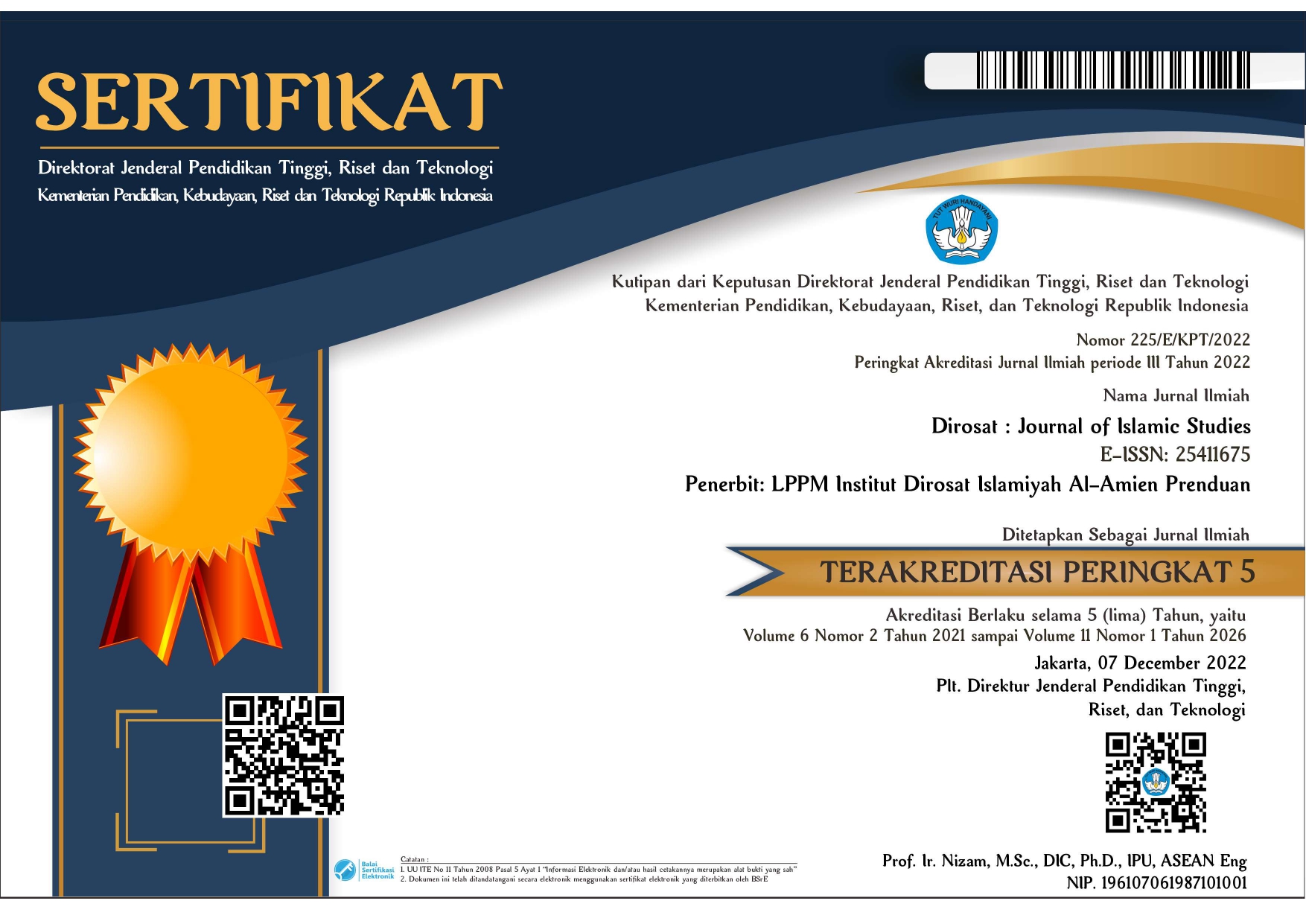QURANIC INTERTEXTUALITY AND YOUTH LIFESTYLE: A TEXTUAL ANALYSIS OF THE TWO GARDENERS IN SURAH AL-KAHF
Abstract
The interpretation of the Qur'an is an effort to explain the meaning of its verses. In the context of Qur'an interpretation, literary criticism, particularly the approach of intertextuality, plays a crucial role in the development of Qur'an Studies. Intertextuality examines the relationship between one text and another by discovering meaningful connections between them. This research focuses on Surah al-Kahf (QS 18) verses 32-44, which narrates the story of two gardeners (Ashâbul Jannatain) and its relevance to the realities of contemporary youth life. The study aims to provide a thematic exegesis (tafsir maudu'i) of the story through the lens of Qur'anic intertextuality, as well as a rational interpretation (tafsir ma'quli) regarding the concept of youth lifestyle depicted in these verses. This study used qualitative research with a descriptive-analytical method. The result concluded that 13 verses in Surah al-Kahf are interconnected with 18 verses within the same surah and 38 verses from other surahs in the Qur'an. The findings reveal that youth lifestyles can be expressed through their activities, interests, and opinions, as portrayed in the Ashâbul Jannatain story. This verse includes a hedonistic or worldly lifestyle and a religious or spiritual one
Keywords
References
al-Andalusy, M. ibn Y. bi A. H. (n.d.). Tafsir al-Muhit al-Juz al-Sadis. Dar al-Kutub al-’Ilmiyah.
Al-Dimashqiy, I. ibn U. ibn K. al-Q. (n.d.). Tafsir al-Qur’an al-’Azim, Volume III. Dar ibn Hazim.
Al-Khalidy, S. A. al F. (1997). al Tafsir al-Maudu’iy. Dar al Fikr.
al-Khawarizmy, A. al-Q. M. ibn ‘Umar al-Z. (n.d.). Al-Kashshaf ‘an Haqa’iq al-Tanzil wa ‘Uyun al-Aqawil fi wujuh al-Ta’wil Juz III. Maktabah Misra.
Al-Khawarizmy, A. al-Q. M. ibn ’Umar al-Z. (n.d.). Al-Kashshaf ’an Haqa’iq al-Tanzil wa ’Uyun al-Aqawil fi wujuh al-Ta’wil Juz III. Maktabah Misra.
Baidan, N. (2012). Metodologi Penafsiran Tafsir. Pustaka Pelajar.
Boullata, I. J. (1990). Trends and Issues in Contemporary Arab Thought. In State University of New York Press (Vol. 27, Issue 10). State University of New York Press. https://doi.org/10.5860/choice.27-5925
Chandler, D. (2022). Semiotics: The Basics; Fourth edition. In Routledge (Vol. 4, Issue 1). Routledge.
El-Awa, S. M. S. (2006). Textual Relations in the Qur’?n: Relevance, Coherence and Structure. In Routledge. Routledge. https://doi.org/10.4324/9780203014486
Engel, J. F., RD, B., & Miniard, P. W. (1994). Consumer Behavior, Volume 1, Translation: Budijanto, Sixth Edition. Binarupa Aksara.
Hadi, M. (1985). Manusia dalam Perspektif Humanisme Agama; Pandangan Ali Shari’ati, dalam buku Konsepsi Manusia Menurut Islam. PT Grafiti Press.
Kasiram, M. (2010). Metodologi Penelitian: Refleksi Pengembangan Pemahaman dan Penguasaan Metodologi Penelitian. UIN MALIKI PRESS.
Mir, M. (1986). Coherance in the Qur’an a Study of Islah’s Concept of Nazam in Tadabur-i Qur’an (p. 11).
Moleong, L. J. (2001). Melodologi Penelitian Kualitafif. Remaja Rosdakarya.
Monks, F. J., Knoers, H. M. O., & Haditomo, S. R. (1998). Developmental Psychology: An Introduction in Its Various Parts. Gadjah Mada University Press.
Nathan A, H. P. D. (2013). The Psychology of “YOLO” “You only live once” is a mantra with good and bad consequences. Psychology Today. https://www.psychologytoday.com/intl/blog/the-big-questions/201309/the-psychology-yolo
Neuwirth, A. (2022). THE QUR’AN TEXT AND COMMENTARY VOLUME 1 EARLY MECCAN SURAS POETIC PROPHECY. Yale UNIVERSITY PRESS.
Nurbayan, Y. (2008). Metodologi Pembelajaran Bahasa Arab.
Qutub, S. (n.d.-a). al-Taswîr al-Fannî fî al-Qur’an. Da>r al-Ma‘a>rif.
Qutub, S. (n.d.-b). Tafsir Fi Zilali al-Qur’an Juz VII. Dar al-Ma’arif.
Rahman, Z. A. (2015). Angelika Neuwirth : Kajian Intertekstualitas dalam surat al-Rahman dan Mazmur 136. Empirisma : Jurnal Pemikiran Dan Kebudayaan Islam, 24(1), 1–20. https://jurnal.iainkediri.ac.id/index.php/empirisma/article/view/12/12
Salam, B. (2002). Individual Ethics: Basic Patterns of Moral Philosophy. c. 1. Rineka Cipta.
Shihab, M. Q. (2009). Tafs?r al-Mi?b?h} Volume 08, Surat al-Kahfi (18). Lentera Hati.
Wansbrough, J. (2004). Quranic Studies: Sources and Methods of Scriptural Interpretation. In Journal of the American Oriental Society (Vol. 100, Issue 2, p. 137). https://doi.org/10.2307/601043
Yakan, F. (1992). Muslim Commitment to Harakah Islamiyah, Translator. Yasir Miqdad. Najah Press.
Youthlab. (n.d.). youth trend 2016 kaleidoscope. Retrieved June 22, 2023, from https://www.enterthelab.com/youth-trend-2016-kaleidoscope/
Zayd, N. H. A. (2004). Rethinking the Qur’an: Towards a Humanistic Hermeneutics. Universiteit Voor Humanistiek, 1–63. www.stichtingsocrates.nl/Zayd/SocratesOratie Nasr Abu Zayd.pdf
DOI: 10.28944/dirosat.v8i2.1851
Refbacks
- There are currently no refbacks.

This work is licensed under a Creative Commons Attribution-NonCommercial-ShareAlike 4.0 International License.








